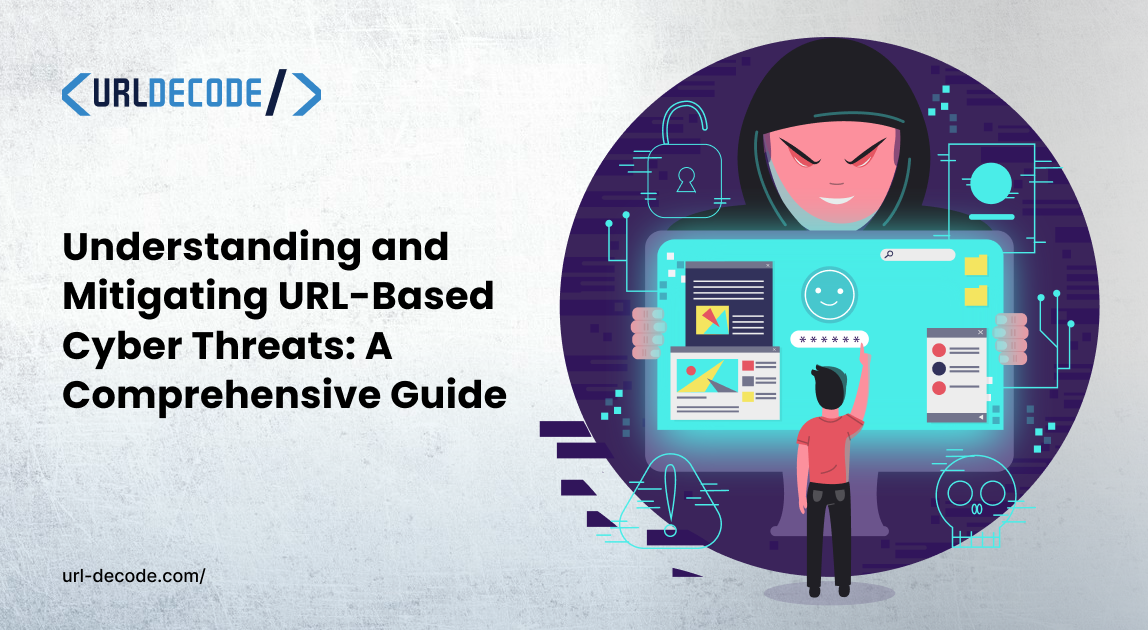Understanding and Mitigating URL-Based Cyber Threats: A Comprehensive Guide

The internet is an integral part of our daily lives, facilitating communication, commerce, and information sharing.
However, its growing significance has also made it a target for malicious actors. One of the most common vectors for cyber threats is through URLs. Malicious URLs are often used to compromise user security, steal sensitive data, or propagate malware.
Similarly, URL decoding is a critical process in cybersecurity, involving the conversion of encoded URL strings into their original readable format. This decoding allows cybersecurity professionals to analyze, understand, and mitigate potential threats hidden within URLs. Encoded URLs are often used legitimately to handle special characters or transmit data through web servers.
Understanding and mitigating these URL-based cyber threats is crucial for individuals and organizations alike. This comprehensive guide explores the landscape of URL-based cyber threats and provides actionable strategies to protect against them.
“Attackers used fake customer support accounts on Twitter to share phishing links. Users clicking these URLs were directed to counterfeit login pages, compromising their accounts.” Cybersecurity News reports.
Common URL-Based Cyber Threats
1. Phishing URLs
Phishing involves tricking users into providing sensitive information such as usernames, passwords, or credit card numbers. Attackers often disguise URLs to appear legitimate, leading victims to counterfeit websites.
An email claiming to be from "YourBank" may include a link like `http://yourbank-security.com,` which redirects to a malicious site. According to a Cyber Press report, a malicious actor registered a typo on a popular e-commerce site to steal payment details during the holiday shopping season.
2. Malicious Redirects
Malicious redirects involve altering website settings or injecting scripts to send users to harmful destinations. This is often used in drive-by downloads to install malware without user consent.
3. Typosquatting
Typosquatting exploits common user errors in typing URLs (e.g., `gooogle.com` instead of `google.com`). These fake domains often host malicious content. One of the best defenses against typosquatting is to buy the .com domain of your brand early to prevent malicious actors from registering similar variations.
4. Shortened URL Exploits
URL shorteners (e.g., `bit.ly`) are convenient but can obscure the destination URL, making it easier for attackers to hide malicious links.
Detection Techniques
1. Analyze URL Structures
Suspicious URLs often contain:
- Unfamiliar domain names or subdomains.
- Excessive special characters or encoded parameters.
- Misspelled or impersonated brand names.
A URL like `http://secure-login.bank-name.example.com` is likely malicious, as the actual domain is `example.com`.
2. Use Security Tools
Employ URL scanners like VirusTotal, URLVoid, or built-in browser security features to analyze and verify links before clicking.
3. Enable Browser Security Settings
Modern browsers include phishing and malware protection. Ensure these settings are activated to receive alerts about suspicious URLs.
4. Leverage AI Analytics and Threat Intelligence
Advanced cybersecurity solutions use AI analytics and machine learning to detect patterns in malicious URLs, providing proactive protection. These cutting-edge artificial intelligence solutions continuously learn from new threats, enhancing their ability to identify sophisticated URL-based attacks.
Preventive Measures
Educating users is the first line of defense against URL-based cyber threats. Training them to hover over links to inspect URLs before clicking and to avoid engaging with links in unsolicited emails or messages can significantly reduce risks.
Additionally, implementing Multi-Factor Authentication (MFA) adds an extra layer of security, ensuring that even if credentials are compromised, unauthorized access is still prevented. Integrating a verify API into your authentication workflows further helps confirm user identities in real time before access is granted. Integrating Privileged Access Management (PAM) further strengthens security by restricting elevated access and minimizing the risk of attackers exploiting stolen credentials. Organizations leveraging Microsoft 365 Backup can enhance their defense with built-in security features such as Safe Links and Safe Attachments, which provide proactive protection against phishing and malicious URLs.
Deploying web filtering tools further enhances protection by restricting access to known malicious websites and preventing accidental clicks on harmful URLs. Deploying web filtering tools further enhances protection by restricting access to known malicious websites and preventing accidental clicks on harmful URLs, which is especially crucial in areas like DeFi smart contract development, where security risks are higher.
Lastly, maintaining up-to-date systems, including browsers, operating systems, and software, is crucial for patching vulnerabilities that attackers frequently exploit. These measures collectively create a robust defense against URL-based threats. For organizations in regulated industries, adopting a legal AI chatbot can also help ensure compliance by guiding employees through cybersecurity policies and flagging risky behavior based on real-time queries.
A large-scale attack reported by a Cyber News platform distributed malware by distributing shortened URLs in SMS messages. Users unknowingly downloaded spyware onto their devices.
Tools To Protect Against URL Threats
- URL Scanners: VirusTotal, URLScan.io
- Web Filtering Solutions: Cisco Umbrella, Zscaler
- Browser Plugins: HTTPS Everywhere, uBlock Origin
- Email Security: Barracuda Email Security Gateway, Mimecast
Conclusion
URL-based cyber threats continue to evolve, exploiting the trust and habits of internet users. However, by understanding these threats and implementing robust security measures, individuals and organizations can significantly reduce their risk of falling victim to such attacks.
Stay informed, leverage the latest tools, and practice safe browsing habits to navigate the digital world securely.




